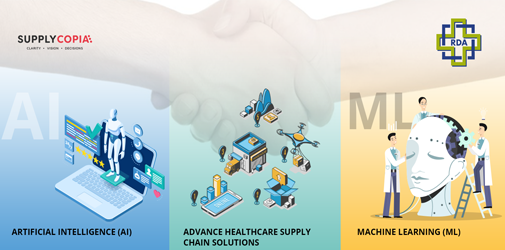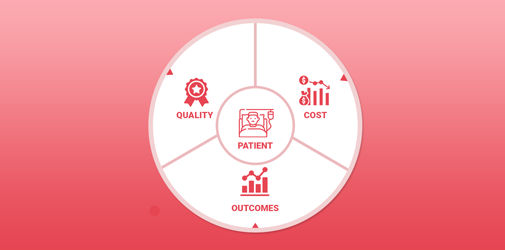ASHOK MUTTIN | January 8, 2024
Top 6 Predictions for the 2024
Healthcare Supply Chain
By Ashok Muttin, CEO & Founder, SupplyCopia
By any yardstick, 2023 was a challenging year with high interest rates, inflation, high acquisition costs, higher inventory carrying costs (residue from the pandemic), labor shortages, and significant changes in the care delivery models.
By comparison, we predict 2024 will be easier as far as cost is concerned. But the world is more divided than ever, with regional powers flexing for their rightful place in the universe.
With so many factors at play, let’s talk about some key areas of concern and what you can to shore up your organization.
Prediction 1: Geo-Political Challenges Will Continue
Escalating tensions between India and China could trigger interruptions to the global supply chain. In the case of a serious conflict, India would likely block the shipping route for China, causing a major disruption to our supply chains. This could directly impact the cost and availability of medical, surgical, consumables and equipment manufactured in China. India meanwhile is becoming known as the “Pharmacy of the world.” With an estimated 13% of all generic drugs manufactured in India, there is potential for shortages of everyday drugs.
Escalating tensions between USA and China create additional supply chain risk. Recent attempts to reduce supply chain dependency notwithstanding, China remains by far the largest manufacturer of medical products. Any major issues likely lead to significant supply chain challenges, higher costs and shortages.
Ready to Act? Organizations must reinvest in supply resiliency. Let’s break down solutions into two major buckets:
- Analyze and understand supplier risk. In discussions with more than 100 medium-to-large health systems, we were alarmed to find none of them have comprehensive risk analysis and mitigation strategies. Now is the time for supply chain leadership to consciously invest in a comprehensive plan. Of course there are internal challenges, like budget dollars needed for analysis. But with a shared base of suppliers across U.S. providers, it may make sense to create a “noncompeting coalition of providers” to collaboratively frame and identify risk, build a shared, standard analysis methodology, and share development costs across the coalition.
- Build plans for alternate manufacturing and distribution. Driven by the shortages and lessons of the pandemic, some manufacturers, GPOs, and health systems have invested in building domestic capabilities; other have moved supply chains to other countries (Vietnam, Thailand, Philippines, India, Mexico). While commendable, it’s likely to take 4-5 years for these investments to have positive impact. Health systems should develop an interim strategy to address near term challenges. This may include building not just a contingency plan, but also an alternate supplier base, proactively managing demand, and stress-testing the supplier network.
Prediction 2: Cost Pressures Won’t Simply Disappear
There’s general agreement today that the Fed is likely to either freeze interest rates or reduce them slightly. Yet we estimate a likely 6-8% increase in the cost of acquisition of supplies. Most raw materials, semi-finished goods and finished goods originate outside our borders, and countries responsible for manufacturing these face their own inflationary and political issues. Adding to this challenge is human behavior: Once suppliers get used to higher product prices, there is little incentive to reduce prices voluntarily. Example: during the pandemic, restaurants increased their pricing between 15-30% due to product shortages, increased raw materials cost, and labor. As we’ve entered this mostly post-pandemic world, have you seen any restaurant prices come down?
Just like a New Year resolution to lose weight, health systems build their own cost-saving plans. Grand plans are announced publicly. “Cost savings is our #1 initiative!” And just like a weight loss goal, these cost reduction goals are generally shelved within a few months. We believe that most healthcare supply chain leaders are well-intentioned and serious about cost savings but tend to give up fairly quickly.
Ready to Act? Let’s address the big issues for supply chain leaders:
- Clarify the vision. Just like a weight loss goal, savings goals must be clear, concise, and realistic. We recommend building realistic goals plus a stretch goal. Break the goals down into markets, business lines, procedures, categories and sub-categories. With manageable components, you can set realistic numbers for improvement, and only then, set a stretch goal that’s 1.5, 2, or even 3 times your realistic goal.
- Solidify the data foundation. The most common impediment to successful analysis is data. If you’ve not yet made investments in your data foundation, this is the year to prioritize the construction of your data foundation. Prioritize a few key areas, and you can build smaller “data marts” to support your analysis and reach cost savings targets.
- Leverage open source and off-the-shelf technology. Generally, healthcare supply chain organizations have under-invested in the technology infrastructure needed to support a sophisticated health system. Thankfully, there’s an abundant availability of open-source and off-the-shelf technology today. If you don’t have accessible internal IT resources, hire software and solutions companies qualified to help reduce your burdensome infrastructure and deliver sustained cost savings.
Prediction 3: New Technologies – ML, AI, NLP – Will Drive Lots of Buzz, Less Actual Transformation
With so much buzz around new technologies and capabilities, there’s no doubt these technologies will have a far-reaching effect on healthcare and the supply chain. Yet we must approach with caution; these aren’t silver bullet solutions to years of chronic problems.
The healthcare supply chain has years of accumulated problems including under-investment in technology foundations, data foundations, system interoperability, lack of standardization, and standardized operating procedures. While we’d like to simply wish those problems away with a Large Language Model (LLM) system, the solution isn’t that simple. There is a lot of legacy we must undo. Example: the largest financial systems still rely on mainframe computers even today.
Ready to Act? Let’s look at what exactly an LLM helps us do:
An LLM is a statistical language model trained on a massive amount of data. It can be used to generate and translate text and other content, and perform other Natural Language Processing (NLP) tasks. LLM is like the combination of millions of individual brains. A individual brain is a marvelous engine that connects, comprehends, analyzes and even predicts based on data that it has seen in the past. Key words: “has seen.” While LLM is very capable of finding the needles in the haystack, e.g., finding a biomarker in cancer data, it’s not yet ready to turn lose on the healthcare supply chain because:
- We need to increase our data foundations and connections. The last decade shows us that most health systems struggle with basic issues of managing their item master and integration with other functions, such as clinical, financial, reimbursements, patient demographics, and procedure outcomes. For example, a stent may be written and classified in a dozen different ways, and a simple supplier name may have ten different variants. If this data cacophony is thrown at any sophisticated LLM model, the only outcome is “garbage in, garbage out.”
- We’re still grappling with PHI, Data Security and Privacy. Unlike other industries, healthcare deals with highly confidential patient data. Even when anonymized, there is significant risk to using it. By definition, the LLM can only learn and provide intelligent answers by consuming large amounts of data. Until LLM providers can create a private cloud to run on the health systems’ or a solution provider’s framework, it is almost impossible to use LLM models.
- Start small. Because the LLM learns only when massive data amounts are ingested, now is the time for health systems and their solution partners to experiment with smaller use cases to investigate technology solutions further.
Prediction 4: It IS Possible to Make Supply Chain Your Strategic Differentiator
While we saw supply chain leaders gain visibility role during the pandemic, there wasn’t enough broad change to land most supply chain leaders in the board room or to made supply chain a strategic imperative. While still the second largest spend, and critical to patient care, somehow supply still sits in the backseat.
Ready to Act? Let’s relook at supply chain strategic imperatives.
- Collaboration Across Functions: Supply chain leaders can focus on fostering collaboration with other functions within the organization, such as clinical, revenue management, and human resources. Building strong cross-functional partnerships helps align supply chain with broader organizational objectives.
- Data-Driven Decision-Making: Leveraging data and analytics enhances decision-making capabilities of supply chain leaders. By demonstrating the ability to derive insights from data, they can contribute to more informed and strategic decision-making processes.
- Innovation and Technology Adoption: Embracing innovation and adopting new supply chain technologies position leaders as forward-thinking contributors. Explore technologies such as blockchain, IoT, and advanced analytics for supply chain optimization.
- Cost Management and Efficiency: Supply chain leaders must emphasize their role in cost management and operational efficiency. Demonstrating tangible cost-saving initiatives and efficient supply chain processes strengthens their position as key contributors to financial health.
- Risk Management: With increasing geopolitical challenges and other uncertainties, supply chain leaders need to focus on robust risk management strategies. This includes identifying potential risks, developing mitigation plans, and ensuring the resilience of the supply chain in the face of disruptions.
Prediction 5: The Healthcare Landscape Evolution Gets Bigger
The reshaping of healthcare continues as the industry struggles to pursue more cost effective models and more efficient organizational structures.
Metamorphosis among Group Purchasing Organizations continues. We’re seeing evidence in areas like:
- Increased sharebacks: Understanding their significant contribution to GPO revenue, large and medium health systems will demand increased percentage of sharebacks. We estimate that this increase was between 0.1-0.22% in 2023 and is likely to increase in 2024, putting greater pressure on GPOs.
- Regulatory framework and safe harbor protection: Rumors around repealing safe harbor protection continue. Whether or not this results in concrete actions, GPOs will gradually shift from admin fee-based models to hybrid or software and solutions-based models.
- Health system-led GPOs: Large health systems with visionary leaders are creating their own GPOs. These new entities are based on the premise they’ll deliver better pricing and outcomes than current GPOs. These new entities incorporate a significant technology and services component into their offerings, by partnering with nimble software companies to reduce time to market and time to value. While these organizations are in their early stages of development, in the next 15-24 months they’re likely to become formidable competitors to national GPOs.
- Significant GPO consolidation: Smaller and regional GPOs have a tough time proving significant value to provider members, and are likely to either fold or be acquired.
- Transparency and accountability: Large health systems continue applying pressure to GPOs for greater transparency and accountability, in turn risking current revenue models.
Meantime, Merger and Acquisition activities continue. Based on publicly available information, there were 53 M&A activities in 2023, which is somewhat unchanged from 2022. While M&A slowed during the pandemic, there were numerous notable M&A transactions in 2023, including:
- Kaiser and Geisinger
- BJC and St. Lukes
- Henry Ford and Ascension Michigan
- University of Michigan Health and Sparrow
- Froedtert and ThedaCare
- Essentia and Mashfield
- Oregon Health & Science University and Legacy Health
And finally, the location of care continues its migration out of the acute care hospital into other, less expensive environments.
- At-home care: Bringing the hospital home is the new tagline of companies providing such services. This model is gaining in popularity, as large health systems – whose entire business model revolves around providing care and getting paid in an inpatient setting – will rethink continuum of care strategies. Our prediction is that large systems will acquire organizations already in this business for integration into their larger ecosystem.
- Inpatient to outpatient setting: No longer an outlier, health systems have shifted a significant portion of procedures to outpatient settings and are seeing success in maintaining high-quality care and outcomes. We predict significant new facility constructions and M&A activity outpatient care in 2024.
Ready to Act? Will it’s likely many factors happening in the larger healthcare ecosystem are beyond the control of the single hospital or even healthcare system, preparing your organization for future success is something leaders can do today. The reasons health systems are looking to merge or acquire are to increase scale (and in turn, reduce cost), gain new competencies, increase lines of business that generate net new revenues, and respond to shifting care delivery models (non-acute and at-home care). Those health systems with significant cash balances will be searching for acquisitions. With so much change underway in healthcare, the evolution will pick up pace; 2024 may even see a 10-15% increase in M & A activities.
Prediction 6: We’ll Increase Focus on Supply Chain Talent and Leadership
Based on multiple surveys, it is estimated that more than 32% of the current supply chain leadership will retire by 2025, creating an enormous knowledge gap that will be difficult to fill unless health systems consciously decide to hire and train data, analytics, and supply chain talent.
Historically, the healthcare supply chain fails to attract the best and brightest because we’ve been less competitive than other industries. When we compare our investment in supply chain talent, healthcare falls behind in terms of salary, benefits, options and perhaps most importantly, upward mobility.
Ready to Act? Create the path from the supply chain leadership role to the board room or C-suite, to bring the best and brightest new talent to healthcare.
About SupplyCopia
SupplyCopia’s AI- and ML-propelled intelligence engine makes it possible to deliver unique cloud-based solutions that improve supply chain related data, processes and analytics for healthcare organizations. SupplyCopia brings together global data sources, advanced technology and world-class data scientists to help our partners achieve greater supply chain and system performance. SupplyCopia improves results for providers and suppliers alike, with solutions deployed globally and locally. Learn more at supplycopia.com.
More from SupplyCopia



 ALL Solutions
ALL Solutions 
